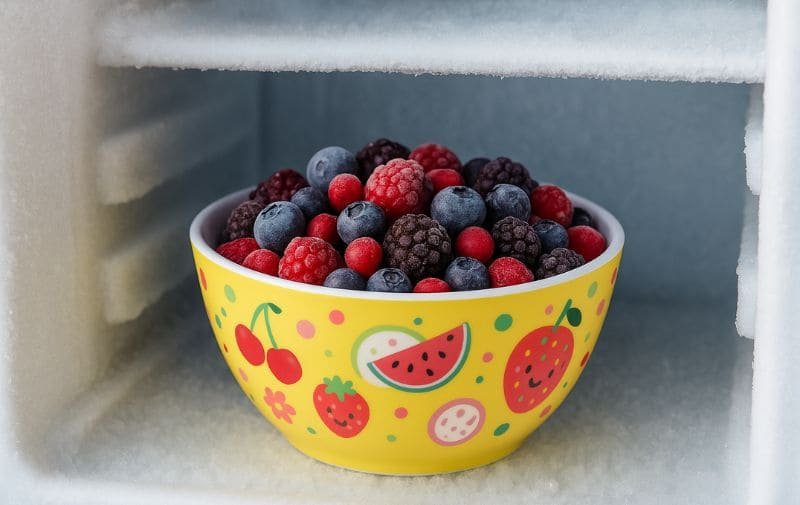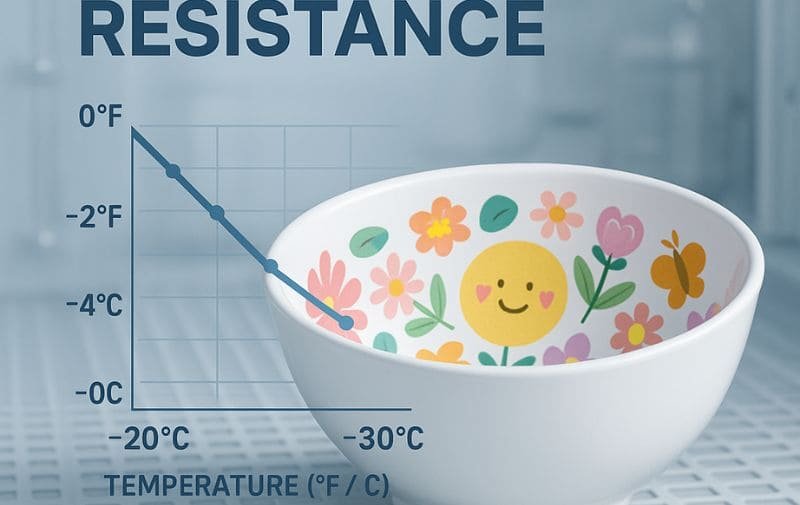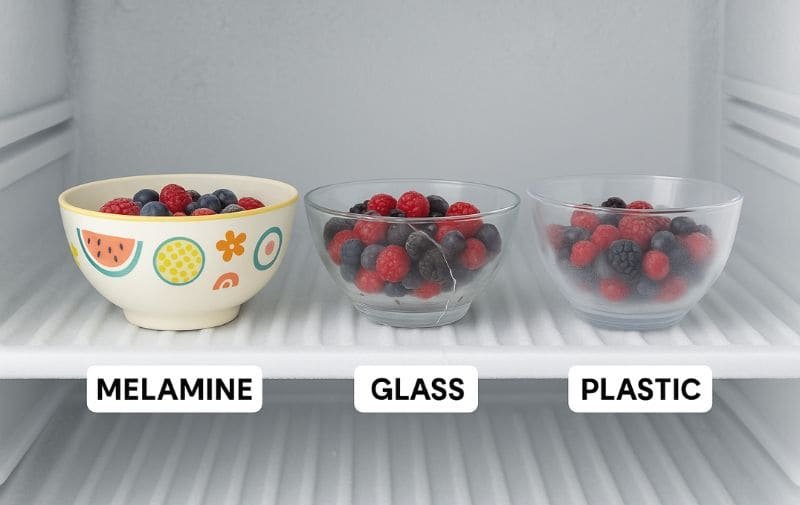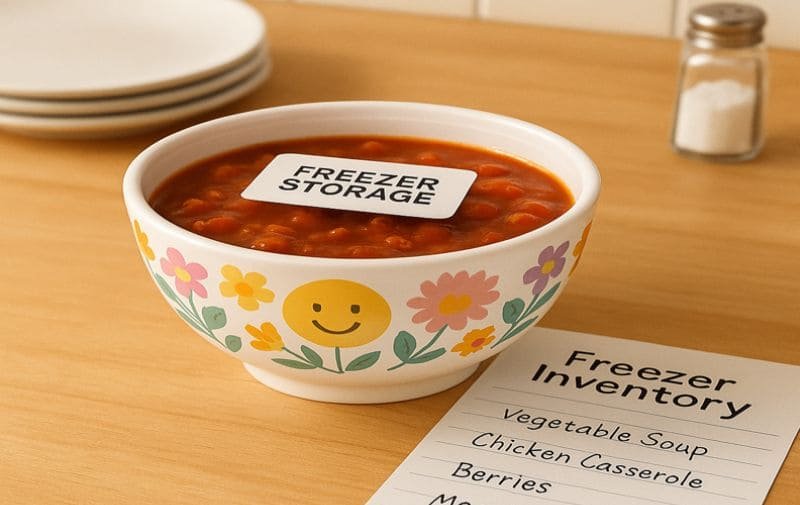You love your stylish melamine bowls, but when it comes to storing leftovers in the freezer, you might pause and wonder: are melamine bowls freezer safe? It’s a common question, especially since melamine has that one big no-no (the microwave!).
The great news is: Yes, high-quality A5 melamine bowls are generally considered freezer safe. They can handle typical household and commercial freezer temperatures without compromising their integrity or safety. However, there are a few best practices to keep in mind.
I remember when I first got my set of vibrant melamine bowls. I loved them for picnics and for the kids, but then came the question of leftovers. Could I pop them straight into the freezer? The big “NO MICROWAVE” warning always made me hesitant about temperature extremes. So, I did some digging, talked to people in the know, and experimented.
Now, I want to share what I’ve learned so you can confidently use (or not use) your melamine for cold storage. Let’s unpack the chilling truths!
Last Updated: 15th.June 2025 | Estimated Reading Time: 9 Minutes

The Big Question Answered: So, Can Melamine Bowls Go in the Freezer?
You’ve got leftovers in a melamine bowl and the freezer seems like the perfect spot. But that nagging doubt – is it really okay for the bowl?
Yes, melamine bowls, particularly A5 grade, are designed to be freezer safe. This means they can endure typical household freezer temperatures without cracking, becoming brittle, or compromising food safety.
When we say “freezer safe” for melamine dinnerware, it means the material can handle the cold without its structural integrity failing. Good quality A5 melamine is tough stuff. It’s made from melamine-formaldehyde resin, which is a thermosetting plastic. Once it’s cured, its structure is pretty stable and rigid, which is great news for cold environments.
Industry insiders often point out that because melamine isn’t microwave-safe, people mistakenly think it can’t handle any temperature changes. However, its performance at low temperatures, typically down to -20°C or even -30°C (-4°F to -22°F), is actually very good. I was relieved to learn this because it opened up more storage options for me
Industry Insider Tip: Many people get confused because melamine is NOT microwave-safe. They assume it can’t handle any temperature extremes. However, its performance at low temperatures is actually very good!
Why Melamine Handles the Cold: The Science Bit Explained
It seems a bit surprising that a material that hates the microwave loves the freezer, doesn’t it? What makes melamine so resilient in freezing temperatures?
Melamine’s stable, thermosetting plastic composition (A5 grade) doesn’t become significantly brittle or change dimensionally at standard freezer temperatures, allowing it to maintain toughness and impact resistance in the cold.
The secret to melamine’s cold-weather performance lies in its chemistry. A5 melamine, the good stuff used for quality dinnerware, is a thermosetting plastic. This means that during its manufacturing process, it undergoes a chemical change that sets its shape permanently. Its molecular structure becomes very stable and rigid.
Unlike some other plastics (thermoplastics) that can get super brittle and crack easily when they get really cold, A5 melamine hangs onto its toughness pretty well. It doesn’t shrink, expand dramatically, or become overly fragile within the normal range of freezer temperatures. This means it’s less likely to break if it gets bumped while frozen. There’s also no significant risk of chemicals leaching into food at these low temperatures, which is a concern often (and rightly) associated with heating certain plastics.
Tip: Think of A5 melamine as being “set in its ways” chemically, making it reliably strong even when chilled.

Refrigerator Safe? An Easy “Yes” for Melamine Bowls!
If they can handle the freezer’s icy blast, surely the refrigerator is a walk in the park for melamine bowls, right?
Absolutely, melamine bowls are perfectly safe for refrigerator use. Refrigerator temperatures (0°C to 4°C or 32°F to 40°F) are well within melamine’s comfortable operating range, making them great for storing all sorts of chilled foods
This makes melamine bowls excellent for:
- Storing leftovers.
- Prepping ingredients ahead of time.
- Marinating foods.
- Keeping salads or fruit preparations chilled.
There are no special considerations for refrigerator use that differ significantly from general care, beyond ensuring food is covered to maintain freshness.
Here’s a quick look at typical temperature ranges:
| Environment | Typical Temperature Range (°C) | Typical Temperature Range (°F) | Melamine Suitability | Icon |
|---|---|---|---|---|
| Household Freezer | -18°C to -30°C | 0°F to -22°F | ✅ Safe | ❄️ |
| Household Refrigerator | 0°C to 4°C | 32°F to 40°F | ✅ Safe | 🧊 |
| Room Temperature | ~20°C to 25°C | ~68°F to 77°F | ✅ Safe | 🏠 |
| Hot Food Serving | Up to 70°C (briefly higher) | Up to 160°F (briefly higher) | ✅ Safe | 🔥 |
| Microwave Oven | Very High (uneven heating) | Very High (uneven heating) | ❌ UNSAFE | 🚫 |
A5 Grade Melamine: The Reliable Choice for Cold Storage
As with most aspects of melamine performance, the quality, specifically A5 grade, is key for reliable freezer use.
- Purity & Curing: A5 grade melamine or bamboo fiber from reputable manufacturers ensures the material purity and proper curing processes necessary for good low-temperature performance and overall food safety.
- Consistency: This grade offers a more consistent and stable material structure, less prone to issues than lower-grade or unspecified “plastic” bowls.
While a slightly higher initial cost might be associated with certified A5 melamine, its durability and dependable performance across various conditions, including freezing, provide better long-term value and peace of mind.
Smart Freezing: What to Watch Out For with Melamine Bowls
While generally safe, a few caveats apply for optimal use:
- Check Manufacturer’s Instructions: Though rare for A5 dinnerware, it’s always wise to quickly check if the manufacturer provides specific freezer guidelines, especially for uniquely shaped or very thin items.
- Avoid Extreme & Sudden Temperature Changes (Thermal Shock): While melamine is robust, it’s gentlest on any material to avoid extreme thermal shock. For example, don’t take a bowl directly from a hot dishwasher and immediately place it in a deep freezer, or vice-versa (like pouring boiling water into a frozen bowl). However, damage from cold-to-hot is far less likely and critical than the damage caused by microwaving.
- Food Expansion: Remember that liquids and foods with high water content expand when they freeze. Always leave some headspace (about an inch) in the melamine bowl to prevent the expanding food from cracking the bowl or overflowing.
| Consideration | Why It Matters for Melamine in the Freezer |
|---|---|
| Food Expansion | Prevents cracking due to pressure from freezing food. |
| Thermal Shock | Gradual changes are gentler, though cold isn’t melamine’s enemy. |
| A5 Grade Quality | Ensures better stability and safety at low temps. |
Best Practices: Freezing Food Safely in Melamine Bowls
Follow these tips for the best experience when freezing food in melamine:
- Cool Food First: It’s good practice (and general food safety) to let hot foods cool to at least room temperature before placing them in a melamine bowl and then into the freezer. This reduces temperature stress on the bowl (however minimal for melamine) and helps your freezer operate more efficiently.
- Use Lids (If Available): If your melamine bowls come with lids, use them to prevent freezer burn and odor absorption. Check if the lids themselves are also rated freezer safe (most accompanying melamine lids are). If not, use plastic wrap or freezer-safe reusable covers.
- Leave Headspace: Crucial for liquids! Allow about an inch at the top for expansion.
- Inspect Bowls Before Use: Briefly check your melamine bowls for any existing deep cracks or significant chips before freezing. While freezing itself is unlikely to cause damage, pre-existing damage could be exacerbated by handling frozen, rigid contents.
- Thawing Safely: The best way to thaw food stored in a frozen melamine bowl is in the refrigerator. You can also use a cold water bath (with the food in a leak-proof bag inside the bowl or transferred to a bag). Remember: DO NOT use a microwave to thaw food while it’s still in the melamine bowl.
Does Freezing Affect Melamine’s Longevity or Integrity?
For high-quality A5 melamine, properly freezing food should not significantly impact the bowls’ lifespan or structural integrity. The material is designed to be stable across a wide range of temperatures (excluding, of course, direct high heat like microwaves or ovens).
Unlike some cheaper plastics that can degrade, warp, or become permanently brittle after repeated freeze-thaw cycles, quality melamine holds up well.
Melamine vs. Other Materials: Freezer Showdown ❄️
How does melamine stack up against other common freezer storage containers?
| Material | Freezer Performance Highlights | Key Advantage for Melamine Over This |
|---|---|---|
| A5 Melamine/Bamboo Fiber | Durable, resists brittleness, good for handling. | – |
| Glass | Non-reactive, clear visibility. | ⭐ Far less prone to shattering. |
| Certain Plastics | Lightweight, often flexible. | ✅ Generally less likely to become brittle than some low-grade or non-freezer-specific plastics. |
| Stainless Steel | Very durable, freezes food quickly due to conductivity. | 🍃 Better insulation for handling (doesn’t get as intensely cold to the touch). |
Family Friendly Tip: For households with children who might be accessing the freezer, melamine’s shatter resistance offers a clear safety advantage over glass containers.

The Critical Reminder: Still NO Microwave After Freezing!
This cannot be stressed enough: Just because a melamine bowl has been in the freezer does NOT change its fundamental unsuitability for microwave use.
The material properties that make melamine unsafe for microwaves are not altered by freezing. Always transfer frozen food to a genuinely microwave-safe dish (like glass or ceramic) for reheating or defrosting in the microwave. Attempting to microwave a melamine bowl, even straight from the freezer, can lead to the bowl overheating, warping, cracking, or potentially leaching chemicals.
Spotting Exceptions to Freezer Safety (And Why They’re Rare)
It’s highly unlikely for a manufacturer of standard A5 melamine dinnerware to explicitly state it’s not freezer-safe. Melamine’s inherent properties make it well-suited for cold temperatures.
Any disclaimer might relate to:
- Extremely specialized melamine formulations not typical for dinnerware.
- Very thin, unusually fragile, or decorative-first designs that might be more prone to impact damage in a crowded freezer, rather than a material limitation to the cold itself.
When in doubt, especially with an unfamiliar brand or an unusually designed item, a quick glance at the manufacturer’s care instructions is always a good fallback. However, for general A5 melamine bowls, freezer use is standard.
Final Verdict: Should You Confidently Use Your Melamine Bowls for Freezing?
Yes, you can confidently use your high-quality A5 melamine bowls for freezing food. They are a durable, practical, and safe option for cold storage.
Key Takeaways for Freezing with Melamine:
- A5 grade melamine is robust at freezer temperatures.
- Always cool food before freezing and leave headspace for expansion.
- NEVER transfer a melamine bowl from the freezer (or anywhere else) to the microwave.
- While melamine is great, for very long-term deep freezing (many months), or if you prefer to go from freezer directly to oven/microwave, then oven-safe glass or specific freezer-to-oven containers might be more versatile for those extended uses.
For most everyday freezer storage needs, your melamine bowls are up to the task!

Frequently Asked Questions (FAQ)
Q1: Can you put hot soup directly into a melamine bowl and then into the freezer?
A: It’s best practice to let hot foods, like soup, cool to at least room temperature before putting them into a melamine bowl and then into the freezer. This minimizes temperature stress (however slight for melamine) and is better for your freezer’s efficiency and overall food safety.
Q2: Will melamine bowls become brittle and crack in the freezer over time?
A: High-quality A5 melamine is designed to resist becoming brittle at typical freezer temperatures. Unlike some cheaper plastics, it should not crack or degrade significantly from the cold itself with normal use and repeated freeze-thaw cycles.
Q3: Are melamine lids also freezer safe?
A: Generally, if a melamine bowl comes with a matching melamine lid, that lid is also designed to be freezer safe. However, if the lid is made of a different, thinner plastic, it’s worth double-checking. If unsure, using freezer-safe plastic wrap or a universal silicone freezer lid directly on the bowl before putting on its own lid can add security.
Q4: Can I use melamine bowls to make ice cream in the freezer?
A: Yes, melamine bowls are perfectly fine for making homemade ice cream or other frozen desserts. Just remember to allow for some expansion of the mixture as it freezes.
Recommended:
- Explore the Melamine Bowl Selection
- Food Safety Tips for Freezing (FoodSafety.gov) – General guidance on safe freezing practices.
- What is Melamine? (Wikipedia) – For general information on melamine resin.



